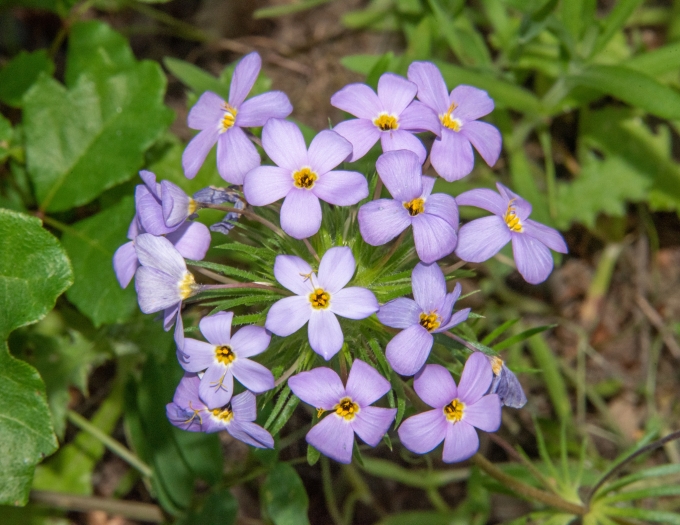False Babystars
(Leptosiphon androsaceus)
False Babystars (Leptosiphon androsaceus)
/
/

Don Loarie
CC BY 4.0
Image By:
Don Loarie
Recorded By:
Copyright:
CC BY 4.0
Copyright Notice:
Photo by: Don Loarie | License Type: CC BY 4.0 | License URL: http://creativecommons.org/licenses/by/4.0/ | Rights Holder: Don Loarie | Publisher: iNaturalist | Date Created: 2020-04-27T12:33:50-07:00 |


















































Estimated Native Range
Summary
Leptosiphon androsaceus, commonly known as False Babystars, is an annual herb native to the open grasslands, chaparral, and open woodlands of California. It can adapt to a variety of habitats within this range. This plant typically produces a hairy stem from 5–45 centimeters (2.0–17.7 inches) long, often growing erect. The tip of the stem is adorned with an inflorescence of flowers one to three centimeters wide, which are usually pink or lavender with yellow or white throats, blooming from late spring to early summer. The flowers are showy and attract pollinators such as bees and butterflies.
False Babystars is valued for its small, colorful blooms that add a delicate texture to garden beds and borders. It is particularly useful in traditional, native plant, drought-tolerant, and wildlife gardens. The plant is easy to grow and maintain, making it a favorite among gardeners who seek to create a naturalistic setting. It thrives in full sun to part shade and requires low to medium amounts of water, making it suitable for xeriscaping. It prefers well-drained soils and can tolerate a range of soil types, from sandy to loamy. While it is not known for any significant problems, it can be short-lived and may need to be reseeded annually to maintain its presence in the garden.CC BY-SA 4.0
False Babystars is valued for its small, colorful blooms that add a delicate texture to garden beds and borders. It is particularly useful in traditional, native plant, drought-tolerant, and wildlife gardens. The plant is easy to grow and maintain, making it a favorite among gardeners who seek to create a naturalistic setting. It thrives in full sun to part shade and requires low to medium amounts of water, making it suitable for xeriscaping. It prefers well-drained soils and can tolerate a range of soil types, from sandy to loamy. While it is not known for any significant problems, it can be short-lived and may need to be reseeded annually to maintain its presence in the garden.CC BY-SA 4.0
Plant Description
- Plant Type: Herb
- Height: 0.3-1.5 feet
- Width: 0.1-0.5 feet
- Growth Rate: Moderate
- Flower Color: Pink, Purple, Yellow, White
- Flowering Season: Spring, Summer
- Leaf Retention:
Growth Requirements
- Sun: Full Sun, Part Shade
- Water: Low
- Drainage: Medium
Common Uses
Border Plant, Low Maintenance, Potted Plant, Rock Garden, Showy Flowers
Natural Habitat
Native to open grasslands, chaparral, and open woodlands of California
Other Names
Common Names:
Scientific Names: , Leptosiphon androsaceus, Leptosiphon parviflorus, Linanthus androsaceus, Gilia androsacea, Linanthus androsaceus subsp. androsaceus, Gilia longituba, Gilia androsacea var. detonsa, Linanthus longitubus, Gilia androsacea subsp. montana
GBIF Accepted Name: Leptosiphon androsaceus Benth.